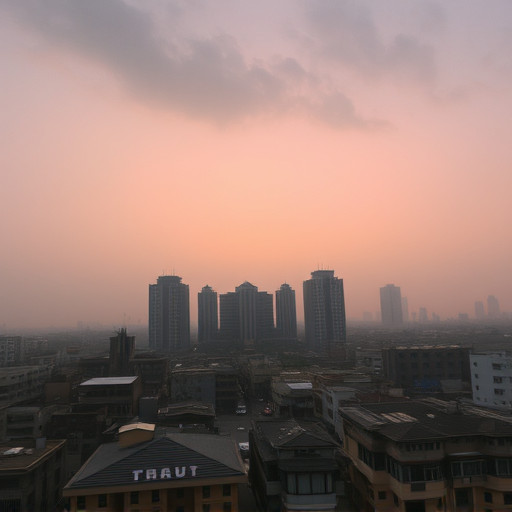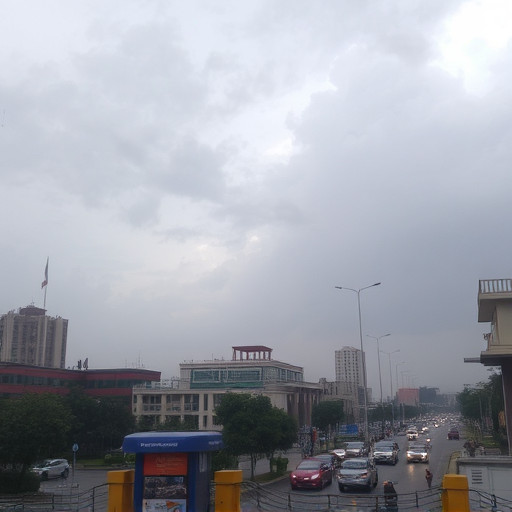
Karachi's geography, characterized by its coastal plain and mountainous northwest, creates a unique wind funnel effect that intensifies prevailing winds, especially during the monsoon season when thunderstorms and strong winds accompany heavy rains. The 'sea breeze effect' further accelerates these winds. Karachi's climate experiences significant seasonal shifts, with westerly winds in winter and southeast monsoon flows in summer, both influencing the city's wind patterns. Urbanization and deforestation have removed natural windbreaks, increasing susceptibility to severe winds which can affect infrastructure and residents. Climate change is exacerbating these conditions by altering atmospheric circulation and intensifying local winds. Wind measurement data has become invaluable for understanding Karachi's seasonal wind variability, guiding urban planning, and improving weather forecasting. This data is crucial for sectors like transportation, construction, and emergency services to manage the impacts of Karachi's dynamic wind conditions effectively. Ongoing monitoring and data analysis are expected to lead to more effective strategies for addressing these challenges.
Windy conditions in Karachi, a sprawling metropolis on Pakistan’s Arabian Sea coast, are not merely an environmental phenomenon but a complex interplay of geographic, seasonal, urban, and global factors. This article delves into the multifaceted causes behind the frequent gales that sweep through the city, examining Karachi’s inherent geographic vulnerabilities, the predictable patterns of its weather, the influences of rapid urban development, the overarching effects of climate change on global weather systems, and the insights gleaned from meticulous wind measurement data. Through this exploration, we aim to unravel the intricate dynamics shaping Karachi’s windy landscape.
- Geographic Vulnerabilities to Wind in Karachi
- Seasonal Patterns Affecting Wind Conditions
- Urban Development and Its Impact on Local Winds
- Climate Change and Global Weather Systems
- Wind Measurement Data and Analysis in Karachi
Geographic Vulnerabilities to Wind in Karachi

Karachi’s geography and climate make it particularly susceptible to windy conditions. The city is situated on the Arabian Sea coast, with its topography characterized by a low-lying coastal plain that extends towards the northeast, bordered by the Kirthar mountain range to the northwest. This configuration funnels prevailing winds from the sea inland, often intensifying their impact. The shape of the land and its proximity to water bodies can amplify wind speeds due to a phenomenon known as the ‘sea breeze effect’. Additionally, the city experiences a distinct monsoon season where the interaction of warm, moist air from the Arabian Sea with the cooler, high-pressure air over the land leads to frequent thunderstorms, which are accompanied by strong winds. The heat of the day accelerates the sea breeze in the afternoons, and during the monsoon, heavy rains can cause sudden gusts that challenge the city’s infrastructure and contribute to urban flooding. These geographic vulnerabilities are exacerbated by factors such as deforestation and urbanization, which remove natural windbreaks and alter the local climate patterns, making the city more prone to severe winds and their associated effects. Understanding these geographic influences is crucial for urban planning and disaster management strategies in Karachi to mitigate the impact of windy conditions on the city’s inhabitants and infrastructure.
Seasonal Patterns Affecting Wind Conditions

Karachi, located on the Arabian Sea coast in Pakistan, experiences a distinct seasonal pattern that significantly influences its wind conditions. During the winter months, from December to February, prevailing westerly winds dominate the region, often bringing cooler air from the higher latitudes. These winds can be quite strong as they flow towards the equator, especially when amplified by the orographic effect of the nearby mountain ranges. The summer season, from June to August, sees a shift in wind direction due to the monsoon flow from the southeast. This reversal brings warm and moist air from the Indian Ocean, which can lead to increased humidity and thunderstorms, further contributing to the dynamic wind patterns observed during this period.
The geographical setting of Karachi, bordered by the Keti Bandar peninsula and the Arabian Sea, plays a crucial role in shaping its wind behavior. The funnel-like shape of the city, with the sea on one side and the mountains on another, can intensify winds as they converge into the city from different directions depending on the season. Additionally, the Coriolis effect, coupled with the topography of the region, influences the wind’s path and velocity, creating conditions that are particularly windy at certain times of the year. Understanding these seasonal patterns is essential for meteorological predictions and for developing strategies to mitigate the challenges associated with high winds in Karachi.
Urban Development and Its Impact on Local Winds

Urban development in Karachi, Pakistan’s largest city, has significantly altered the local climate and exacerbated windy conditions. The rapid expansion of the city, characterized by unplanned construction and land-use changes, has led to the modification of the urban landscape. Tall buildings and expansive concrete surfaces disrupt natural airflows, leading to turbulence and increased wind speeds in certain areas. This anthropogenic interference with the local geography has resulted in the urban heat island effect, where surfaces absorb and retain more heat than surrounding rural areas. Consequently, differences in temperature between the city and its outskirts create thermal low-pressure areas within the urban environment, pulling air into the city and amplifying wind velocities.
Furthermore, the concentration of industrial activities and vehicular traffic in specific zones contributes to pollution, which can affect atmospheric stability and wind patterns. Emissions from these sources not only degrade air quality but also influence wind behavior by altering the thermal properties of the atmosphere. The interplay between urban geometry, heat absorption, and human-induced pollutants thus creates a complex system where winds are both shaped and intensified by the very presence of the city. This dynamic interplay underscores the importance of sustainable urban planning and development practices in mitigating the impact of windy conditions and improving environmental quality in Karachi.
Climate Change and Global Weather Systems

Climate change has a profound impact on global weather systems, including the wind patterns that influence conditions in Karachi, Pakistan. The increasing concentrations of greenhouse gases in the atmosphere due to human activities are enhancing the greenhouse effect, leading to higher global temperatures and altered atmospheric circulation. This shift in climate dynamics can intensify local winds as the gradient of pressure systems widens or shifts. The modification of jet streams, which influence weather patterns at a global scale, can also lead to more pronounced monsoons in South Asia. These changes are not only affecting rainfall patterns but also the frequency and strength of wind events, contributing to the prevalence of strong winds in Karachi during certain periods of the year.
The interconnectedness of climate systems across the globe means that a change in one region can have far-reaching effects. For instance, the melting of polar ice caps, a direct consequence of global warming, alters sea surface temperatures and, consequently, influences atmospheric pressure distributions. These shifts can manifest as alterations in seasonal wind patterns over regions like Karachi, where the prevailing winds are subject to change. The city’s geographical location near the Arabian Sea also plays a role in its weather patterns; the sea acts as a heat sink and can amplify the warming effect, leading to increased thermal contrasts between land and water that drive stronger winds. Understanding these complex interactions is crucial for developing accurate wind forecasting models and for adapting to the changing climatic conditions.
Wind Measurement Data and Analysis in Karachi

In recent years, wind measurement data has been instrumental in understanding the wind patterns and conditions in Karachi, Pakistan’s largest city. A network of anemometers across various locales within the city has provided consistent and reliable data, capturing the variability and intensity of winds throughout different seasons. This data has shown that Karachi experiences predominantly northwesterly winds during the summer months, which can reach high velocities, contributing to the windy conditions that the city frequently encounters. The analysis of these data sets has also revealed a distinct shift in wind patterns during the monsoon season, with easterly winds becoming more prevalent and often bringing relief from the intense heat. Researchers have utilized this data to create detailed models of wind flow within the city, which have been pivotal in planning urban development and improving the infrastructure to mitigate the challenges posed by the strong winds, such as managing dust storms and ensuring the stability of temporary structures.
The meticulous recording and analysis of wind measurements in Karachi have not only enhanced our understanding of the local climatic conditions but have also been a key factor in forecasting weather-related events. By leveraging statistical tools and advanced computational models, climate scientists can predict potential windy periods with a high degree of accuracy. This predictive capability is invaluable for various sectors, including transportation, construction, and emergency services, enabling them to prepare adequately and minimize risks associated with extreme winds. The continuous monitoring and analysis of this data will undoubtedly contribute to the development of more effective strategies for managing and adapting to the dynamic wind conditions experienced in Karachi.
windy conditions in Karachi are a multifaceted phenomenon influenced by the city’s geographic layout, seasonal weather patterns, urban development, and broader climate change effects. The analysis of wind measurement data underscores the importance of these factors in shaping local wind dynamics. Understanding these interrelated elements is crucial for mitigating the impacts of strong winds on the city’s infrastructure and population. As efforts continue to address urban growth and adapt to a changing climate, ongoing monitoring and research are imperative to effectively manage Karachi’s windy conditions.


